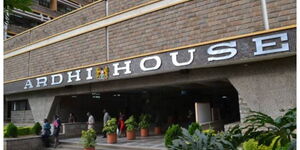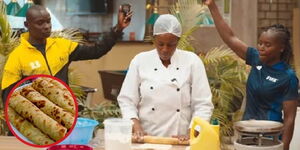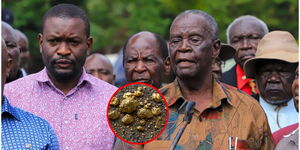TV has become a totally different beast compared to what it was a few years back. The battle for the audiences has intensified, changing the TV landscape, especially Prime Time News, for the better.
From daily news bulletins that are themed around the burning issues of the day or week, to weekend editions that take a magazine approach, spiced with showbiz and a mix of human interest stories.
Citizen TV was the first to go for the jugular by lining up an all-star team, most of whom they had poached from rivals, prompting robust responses that saw the industry change completely.
Anchors now try all kinds of on-air antics as they wrestle for eyeballs. Citizen TV anchor, Jeff Koinange for instance. Like many other anchors in the digital era has signature antics that keep viewers entertained and glued to the TV.
Besides his signature curly hair and deep baritone, the award-winning anchor has branded his style and has trademark phrases with a show full of drama and antics that keep the audience engrossed.
“Oh my! my name is Jeff Koinange. Remember to tweet @Koinangejeff and the hashtag is JKLive,” Koinage always roars, before pausing to sip coffee and adjust his three-piece suit.
“Remember the three letters on the keyboard that follow each other, J, K and L and JKLive begins taanight!” he always adds, rather cheekily.
Years ago, one could not spot an extinguisher or a hanging rack inside a studio. Even a rag which Koinange once sat on while watching a feature story he covered abroad.
Studios, years ago, were relatively tiny with perhaps only one camera focusing on the news anchors whose eyes were fixated on the teleprompter as if his or her life depended on it. It was serious business, or so it seemed.
The camera shot was basically a medium. Anchors did not have space to roam or dance around as Koinange does from his seat to a sofa set across the room, where he interviews his guests. Or to a magic wall where he reads feedback from.
The big set with different hosting areas and multiple cameras have become common. We often see Citizen TV's Yvonne Okwara move from the main set to a nearby screen, where she scribbles things as she breaks down data under a popular segment on her show dubbed The Explainer.
It's also common to see NTV or KTN New hosts stroll through the newsroom as they present news or interview guests. At times, it always looks like an attempt to show off their state-of-the-art broadcasting equipment!
News reading was precise and straightforward; priority was given to politics, especially any news relating to the government. Media houses had their segments monotonously packaged into news, sports and weather, with the larger chunk of it dedicated to events by the Head of State.
Today things have changed, at times some shows are now shot in hotels or in newsmakers' homes. During the Covid-19 pandemic, some anchors presented news straight from their living rooms.
Frank Otieno, KTN Swahili anchor and Manager - Newspaper Education at Standard Media Group says that the changing face of TV and related media trends are occasioned by the change in the consumption of news. Anchors, he adds, are now big brands and that comes with all manner of dynamics in regard to how they present news.
“The transformation of news reading is as a result of the changing trends in news consumption. The current consumers of news interact with content digitally and are always ahead of the anchor.
“The anchor, therefore, has to find a way of making the content worth watching or listening to, to make it interesting,” he told Kenyans.co.ke.
News presentation is considered less formal, co-anchors at times pause in between the presentation to share their opinions or express emotions, in a bid to connect with the viewers.
In some instances, they adlib or crack jokes. Once in a while they get it horribly wrong, attracting the wrath of social media users. We now have shows that are modelled around big personalities.
An example is Citizen TV's power couple of Lulu Hassan and her husband Rashid Abdalla, who host the weekend Swahili news together. The duo also hosts a popular interactive talk show, which targets husbands and wives.
KBC also revamped its studio and hired veteran journalists, Tom Mboya, Catherine Kasavuli, Badi Muhsin, Cynthia Nyamai and Fayaz Kureish. The anchors led a rebranding program to ensure KBC competes with the other media houses.
"(KBC has) invested a lot in software and hardware, a modern television anchoring set, and as such we will fully start broadcasting on High-Definition technology unlike before where we used to combine HD and SD. It’s big-time for us,” KBC Editor-in-Chief Samuel Maina stated.
The 2020 Reuters Institute Digital News Report detailed that world markets, including Kenya and South Africa, have seen a sharp rise in the consumption of news through digital media and mobile media.
Anchors use all means to win over online audiences. Some share behind the scenes videos, exclusive images of their shows and also connect with viewers by sharing their daily activities.
University of Nairobi School of Journalism and Mass Communication Professor, Hezron Mogambi says that the internet and social networks have changed TV.
“What the internet and social networks have done is to give audiences and newsmakers the ability to share information even before it's processed.
“To keep up with these changes, media houses should have regular and constant training modules to keep the teams updated on changes in the industry. This will help them keep pace and keep shaping public opinion and setting the agenda in a much more immediate and global way.”
Digital strategist Brian Muuo adds that anchors who connect with followers on social media also tend to have more viewers online and offline.
Media houses, he states, are now hiring digital teams to curate content and engage fans to create an authentic following and engagements, which they can use to bargain for higher pay or attract new job opportunities.
“If you have many followers while working for a small TV station, you're going to get poached by a big media house because they are competing online and offline.” Muuo details.
Trends, he adds, are significant for any media house and its anchors as viewers give feedback during a bulletin in real-time and can influence each other. If a TV show is trending, other viewers will want to see why it is trending, as per the social media guru.
“Organic trends are happening but it has now also led to TV stations buying engagement from influencers to trend their news bulletins in an attempt to increase viewership. Tablets and Phones are making it easier for the audience to consume news 24/7 on YouTube or aggregation sites like Kenyamoja.
“This has prompted stations to increase their news bulletins from the regular 1 pm, 4 pm, 7 pm and 9 pm to include segments in the morning and in-between major bulletins. The new segments have also given new anchors platforms to thrive,” he explains.
Although there is a significant competition between social media and the TV, prompted by the former having a wide reach and streaming too, Muuo argued that the two can be blended for news.
“Streaming is a revolution, it will not fade out the TV but what is most likely to happen is that TV sets will come pre-installed with the ability to stream YouTube or other platforms.












